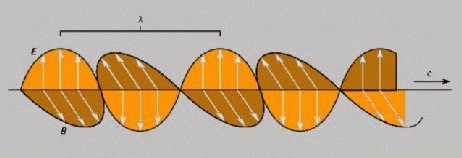|
|
|
|
Due to its charge, an immobile electron generates an electric force in the space surrounding it — the electric field — the strength of which diminishes proportionally to the square of the distance from the electron.
Let's suppose that we can make the electron oscillate backwards and forwards: the electric field in the surrounding points is disturbed because of the change in distance of the electron during oscillation.
A variation in the electric field generates a magnetic field. These oscillations of the electric field — and therefore also the magnetic field — spread out from the electron, generating electromagnetic waves.
A second electron, immobile at a certain distance from the first one, will begin to oscillate as soon as it is hit by the electromagnetic wave produced by that electron. And the electric field of the second electron will then be disturbed by its oscillations and will in turn generate a magnetic field, so allowing for the propagation of the wave itself.
The dimension of a wave (i.e. its amplitude) gives a measure of the intensity of the electromagnetic wave; in other words, the energy of the electromagnetic field transported by that wave.
Radiation is therefore made up of electromagnetic waves, consisting of the alternating oscillation of an electric field and a magnetic field. These waves spread in a direction orthogonal to the direction of oscillation of the two fields.
 Fig. 2: Diagram showing the propagation in time of an electromagnetic wave. |
An electromagnetic wave is emitted every time a charged particle is subjected to acceleration induced by an external force.
Since electrons are 1000 times lighter than protons, they are accelerated much more easily and so produce all the radiation.
If the electron moves uniformly, it drags behind it its own electric field (and magnetic field) and DOES NOT emit radiation. But, if it comes to an abrupt stop, the electromagnetic field starts to oscillate and proceeds in the form of a wave.
Radiation, therefore, depends on the acceleration and NOT on the speed of the electron.